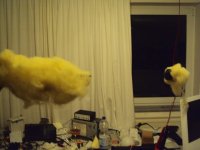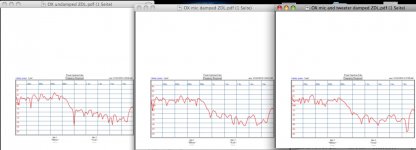When i look at my OX plots on a string at 10kHz the energy is already down 12dB at 90°.
To have too much treble to the back maybe a bad idea anyway. The onmis i heard so far like Ohm F and MBL had a slightly confuse image in the setups i trid them. I think they really need a big room to work well.
To have too much treble to the back maybe a bad idea anyway. The onmis i heard so far like Ohm F and MBL had a slightly confuse image in the setups i trid them. I think they really need a big room to work well.
I have now measured the OX tweeter on a string without damping, with mic damping and with mic damping plus tweeter damping in the back. As expected, the frequency responses look very similiar, the red one ( both damped ) shows the least "rippleness" but not much.
You have to look carefull. This time i put the mic a bit closer at 25cm from the tweeter.
The Power Cepstrum reveils more. Most profitable is to damp the mic. The tweeter damped on the back again does a very slight improvent but i do not know if this is audible and it is only measured on axis. Maybe i have to do more damping in the back to avoid the roudabout effect ( i like that phrase, do you ? ).
You have to look carefull. This time i put the mic a bit closer at 25cm from the tweeter.
The Power Cepstrum reveils more. Most profitable is to damp the mic. The tweeter damped on the back again does a very slight improvent but i do not know if this is audible and it is only measured on axis. Maybe i have to do more damping in the back to avoid the roudabout effect ( i like that phrase, do you ? ).
Attachments
Isn't that what MBL intended to do?The higher the frequency, the harder it gets to build a pointsource. I will be happy when i get a decent 180° coverage up to 10kHz.
However, if you have a Klippel scanner, it should be evident what is necessary after scanning a variety of drivers.
Last edited:
I am not building an omni here. What i try is to minimise is the impact of reflexions on the loudspeaker structure. I use the Klippel for driver development and i work closly with suppliers that use the Klippel so we talk the same language but this is irrelevant in this context. The drivers that i will use are already choosen. I may try different tweeters though but the OX is more or less what i am searching for and it is dirt cheep so it fits into a DIY environment. Imagine a speaker that can do things a commercial speaker can not do and you can build it easy and without high cost. That is what i am trying. I value intelligence and visionary design higher then cost.
For all frequencies in the band pass? Sounds too perfect. But of course, if the goal is to use the dirt cheap approach, many things can be ignored. Just shave everything to bareminimum size. A little more consideration should be taken for the larger driver/encolsure under the tweeter, that's where a more integrated design needs to take place to reduce diffraction.
Well, the drivers i will use are not dirt cheap. For example the Scan midrange is one of the best i know and it costs around 100,-€ retail. It only happens that the tweeter is very affordable and i will try others. What happens under the tweeter will be intesting for sure.
I have tried several vesions of the Vifa wideband and it can not compete with the Scan Speak. Sensitivity of the Scan is much higher and i need that to match the woofer.
Sorry that i brought that "dirt cheap" argument up. Most of the cost ( alternative hours of work ) is in the cabinet anyway. The Peerless woofer is of simple contruction but it works very well in my application. I whould be hard pressed to recommend another woofer that does the same. Most modern woofers have very low Q and low sensitivity and are optimised for a rather small cabinet. The parameters of the Peerless sugest a big box but i am not going for a high WAF here.
Sorry that i brought that "dirt cheap" argument up. Most of the cost ( alternative hours of work ) is in the cabinet anyway. The Peerless woofer is of simple contruction but it works very well in my application. I whould be hard pressed to recommend another woofer that does the same. Most modern woofers have very low Q and low sensitivity and are optimised for a rather small cabinet. The parameters of the Peerless sugest a big box but i am not going for a high WAF here.
The SEAS CA26RFX whould work too. It has a cast basket so it is more pretty. Anyway, i will try the Peerless.
I had some comunication with Mr.Stoll and he told me that a theoritical ZDL can be made in too ways : A single point source in open space (4pi ) and a single point source in an infinte baffle ( 2pi ). In both cases the soundpreasure and soundpower are contsant. That the soundpower is constant too is one of the secrets of the ZDL concept. This is posible in praxis to a first order aproximation only but sittig close in front of a Stoll spaeker gives me much of what i like so i am optimistic that i find a good compromise. In many studio i saw spaekers build into the wall, so they are put in a good aproximation of an infinite baffle. Nevertheless i never heard a deep soundstage or this disappearing act. I than asked Domink why that is soo, although in theory it should work. He answered that most systems are not carefully enough done and he whould be able to build a speaker into a wall that also disappears. I really whould like to hear THAT, but when Mr.Stoll says so there is a good chace that could work.
I had some comunication with Mr.Stoll and he told me that a theoritical ZDL can be made in too ways : A single point source in open space (4pi ) and a single point source in an infinte baffle ( 2pi ). In both cases the soundpreasure and soundpower are contsant. That the soundpower is constant too is one of the secrets of the ZDL concept. This is posible in praxis to a first order aproximation only but sittig close in front of a Stoll spaeker gives me much of what i like so i am optimistic that i find a good compromise. In many studio i saw spaekers build into the wall, so they are put in a good aproximation of an infinite baffle. Nevertheless i never heard a deep soundstage or this disappearing act. I than asked Domink why that is soo, although in theory it should work. He answered that most systems are not carefully enough done and he whould be able to build a speaker into a wall that also disappears. I really whould like to hear THAT, but when Mr.Stoll says so there is a good chace that could work.
 Hello Joachim,
Hello Joachim,So many variables, so many tools and so few models.
The goal or my view of it is to create a believable illusion of realism. To help create the illusion is to eliminate sounds that we in our brains know do not exist at a live event. As the name of your creation points out, diffractions are included in the list of sounds that do not occur at a live event. Coming from the other end of the spectrum (the anagram is unjumbled here) a live event has reflections from the space boundaries that are accepted by our perception as being real. As pointed in the AES papers you attached in early posts, placement of the speakers away from the space boundaries adds to the quality of the sound stage or phantom image. Perhaps large speaker panels or including drivers in the boundaries block the rear wraparound reflections from happening and remove an element of the realism from the listening experience.
Just musings.
DT
All just for fun!
If we look at the energy levels, I think driver stored energy influences sound coloration far more than the speaker/driver diffraction. What the speaker/driver diffraction does is slightly smear the image focus.
The room acoustics during recording is probably the best indication of how good a playback is. If have found that when the music playback polarity is not correct, then this part of the recording is not realistically reproduced.
The room acoustics during recording is probably the best indication of how good a playback is. If have found that when the music playback polarity is not correct, then this part of the recording is not realistically reproduced.
Last edited:
- Status
- This old topic is closed. If you want to reopen this topic, contact a moderator using the "Report Post" button.


